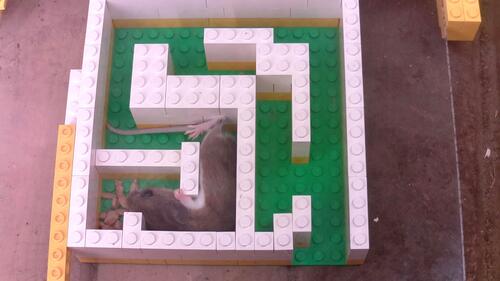 After the success of my mouse gap squeezer teaser
machine video I wanted to experiment more with mice in Lego mazes. Lego
are great for this kind of maze.
After the success of my mouse gap squeezer teaser
machine video I wanted to experiment more with mice in Lego mazes. Lego
are great for this kind of maze.
 After the success of my mouse gap squeezer teaser
machine video I wanted to experiment more with mice in Lego mazes. Lego
are great for this kind of maze.
After the success of my mouse gap squeezer teaser
machine video I wanted to experiment more with mice in Lego mazes. Lego
are great for this kind of maze.
Having established that a mouse could get through a 12 mm gap with my previous experiment, I figured two studs, or 16 mm, would be a wide enough passage for the mouse. I built a small maze to test. The mouse was able to make it around all the corners, though with some effort.
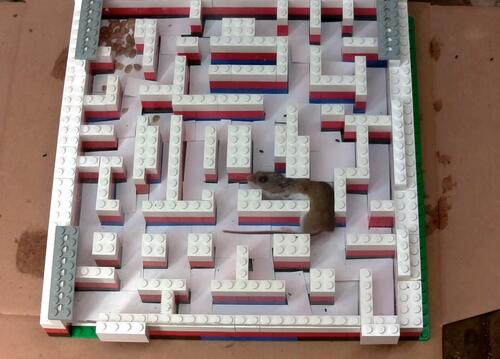 I stayed with the two-stud passage size and made a bigger maze. I figured tight
passages to slow the mouse down would be good, because my ultimate goal was to
see if the mouse could still navigate the maze while it was spinning, and I didn't
want the mouse to be able to get out before the maze turned much.
I stayed with the two-stud passage size and made a bigger maze. I figured tight
passages to slow the mouse down would be good, because my ultimate goal was to
see if the mouse could still navigate the maze while it was spinning, and I didn't
want the mouse to be able to get out before the maze turned much.
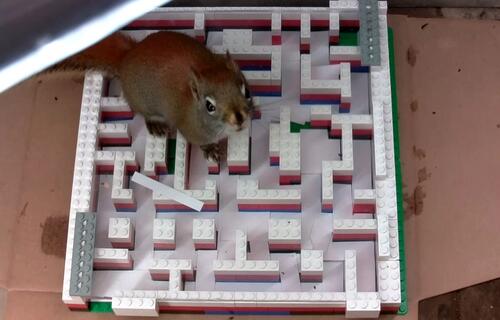 But then a squirrel got into the shed where I was filming it.
But then a squirrel got into the shed where I was filming it.
I noticed there were large gaps under he rafters of the shed, so I sealded those up.
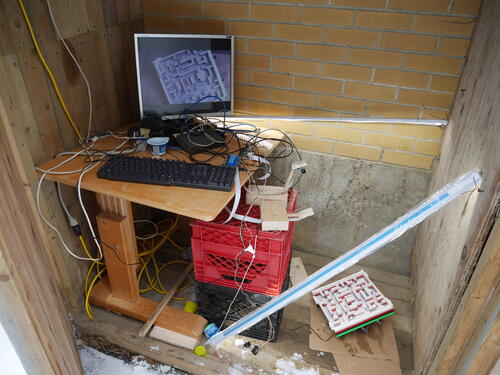
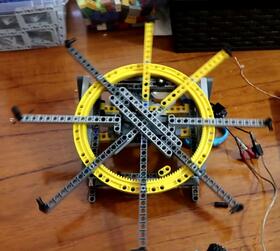 The next phase of the experiment was supposed to be to spin the maze once the
mouse was all the way in it to disorient it.
I built a rotating platform for my Lego maze, also from Lego.
I set this up this was the beginning of January.
The next phase of the experiment was supposed to be to spin the maze once the
mouse was all the way in it to disorient it.
I built a rotating platform for my Lego maze, also from Lego.
I set this up this was the beginning of January.
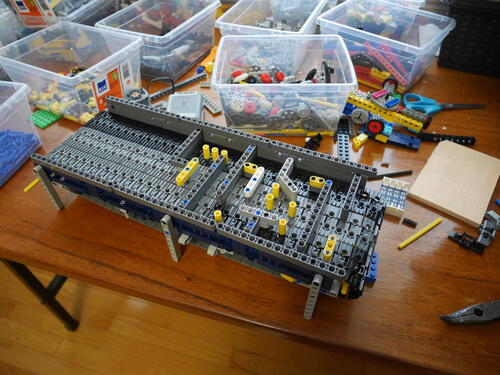 In the mean time, I had all kinds of ideas for future experiments, like
this infinite conveyor belt maze that I built. That was going to
be after the spinning maze.
In the mean time, I had all kinds of ideas for future experiments, like
this infinite conveyor belt maze that I built. That was going to
be after the spinning maze.
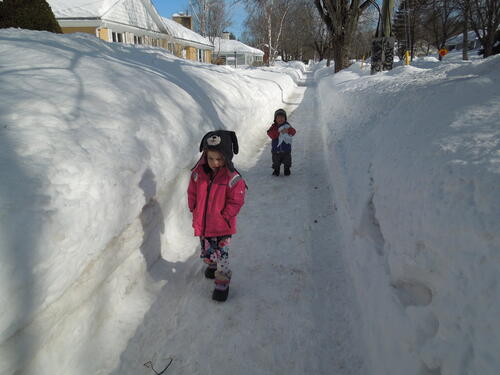 But having set up the next phase of the experiment, the mouse didn't come back.
The winter got colder and the snow deeper and deeper, I had
the cameras running for all of January, and the mouse never showed up.
But having set up the next phase of the experiment, the mouse didn't come back.
The winter got colder and the snow deeper and deeper, I had
the cameras running for all of January, and the mouse never showed up.
I figured I must have accidentally blocked the mouse's entrance into the shed.
Eventually, I stopped shovelling out the entrance to the shed and just shut off power to my experiment.
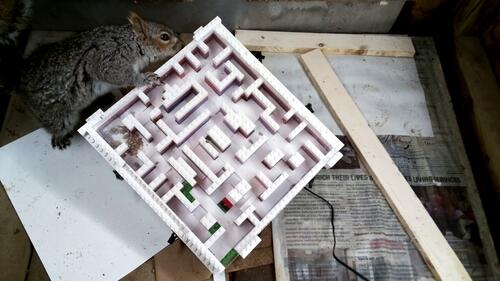 But by April, most of the snow was gone, and I looked into the shed and
saw some signs of activity, though it didn't look like the mouse had
ever made its way into the maze. But I turned the lights and cameras on again.
But by April, most of the snow was gone, and I looked into the shed and
saw some signs of activity, though it didn't look like the mouse had
ever made its way into the maze. But I turned the lights and cameras on again.
But then a squirrel showed up. I guess I hadn't really mouse proofed that shed after all. Fortunately, my apparatus stood up to the big grey squirrel's attempt at getting at the sunflower seeds.
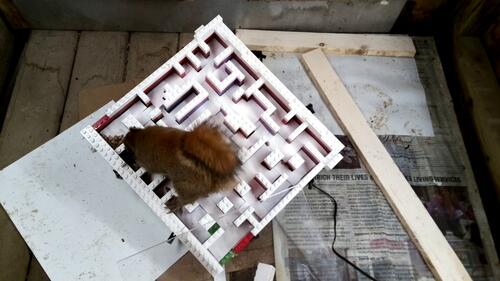 But then a smaller red squirrel showed up, and it made quick work of removing
the plexiglass cover to get at the food. It cleaned the maze right out!
But then a smaller red squirrel showed up, and it made quick work of removing
the plexiglass cover to get at the food. It cleaned the maze right out!
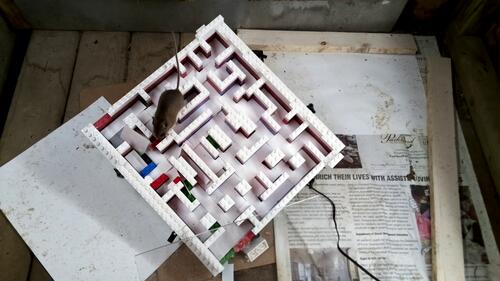 And then a few days later, the mouse shows up again. But by this time, the experiment
had been completely vandalized by the bushy tailed tree-rats.
And then a few days later, the mouse shows up again. But by this time, the experiment
had been completely vandalized by the bushy tailed tree-rats.
But so much time has passed since I started the experiment, that I should really start over again using what I learned. I should make the passages wider so that it's more about the mouse solving the maze and less about squeezing through tight corners. And for the rotating mechanism, it makes more sense to use the sturdier wooden rotating platform I since built for my infrared heater aimer
 But as of mid February 2019, my mouse videos have seen an 80% drop in traffic.
This is probably collateral damage of a YouTube algorithm change, or at least
it coincided with when they changed the algorithm to show less of the
controversial independent "fake news" and more mainstream TV-like content.
But as of mid February 2019, my mouse videos have seen an 80% drop in traffic.
This is probably collateral damage of a YouTube algorithm change, or at least
it coincided with when they changed the algorithm to show less of the
controversial independent "fake news" and more mainstream TV-like content.
Not that the mouse videos aren't still doing fairly well compared to my other videos, but before mid February, they were doing absurdly well, almost as if they triggered some sort of bug in the YouTube algorithm.
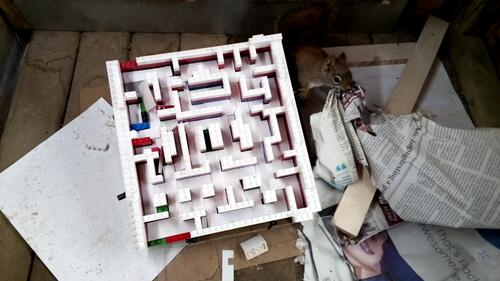 Believe it or not, it's all about getting views, though some
commenters on YouTube seem to fail to grasp the idea that people who work hard
at making videos videos would like their work to be seen a lot.
At any rate, for now, my motivation for making more mouse videos isn't
what it was, so I'm not in a rush to set up more experiments.
Believe it or not, it's all about getting views, though some
commenters on YouTube seem to fail to grasp the idea that people who work hard
at making videos videos would like their work to be seen a lot.
At any rate, for now, my motivation for making more mouse videos isn't
what it was, so I'm not in a rush to set up more experiments.
In the mean time, having depleted the food in my setup, the red squirrel came back and scavenged the newspaper to pad it's nest.
More mouse videos:
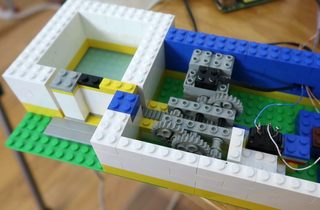 Mouse experiment setup vlog (2018)
Mouse experiment setup vlog (2018)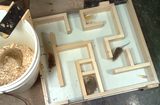 Mouse trap maze experiments (2016)
Mouse trap maze experiments (2016)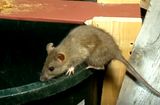 Rat trap fail (2016)
Rat trap fail (2016)
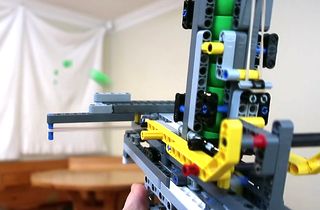 Lego repeating crossbow (video only)
Lego repeating crossbow (video only)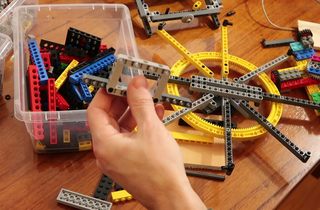 Lego technic new vs. old (video only)
Lego technic new vs. old (video only)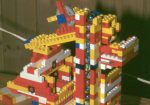 Lego marble machine (from 1996)
Lego marble machine (from 1996)